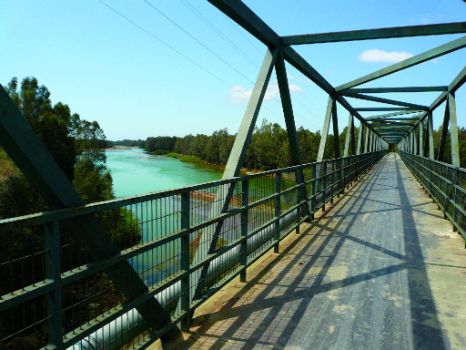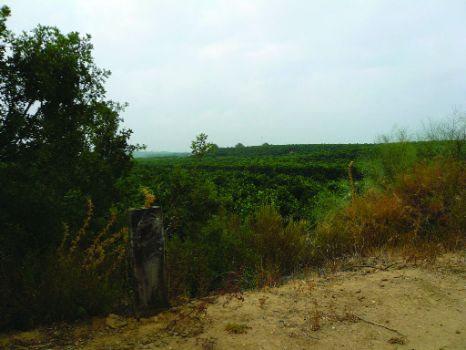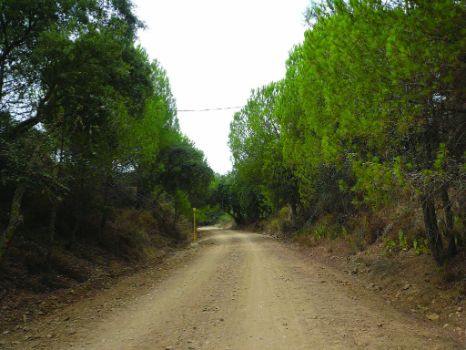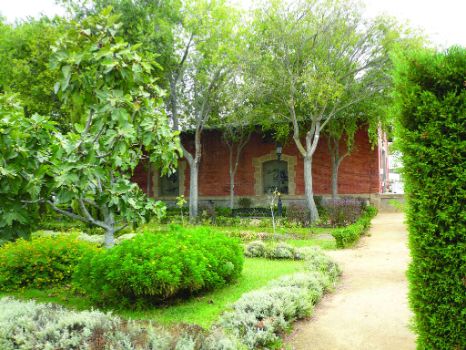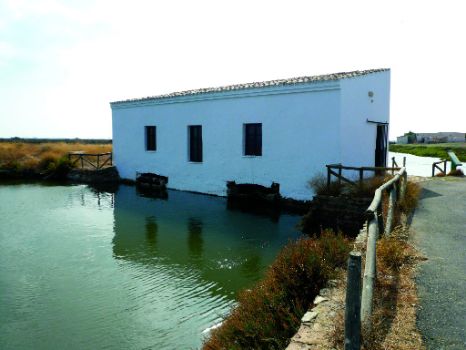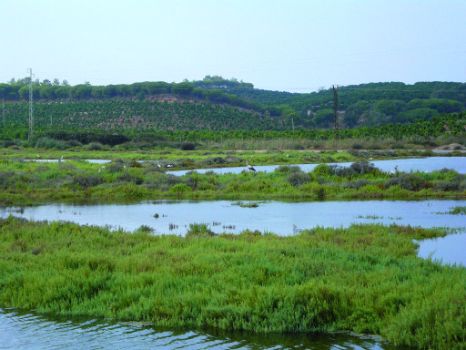Net of Natural
Trails

Litoral Greenway Nature Trail
Description
- - - - - - - -
IMPORTANT WARNING!
DUE TO RESASONS BEYOND THE CONTROL OF THE NATURE TRAILS PROGRAMME, THE CONSERVATION CONDITIONS OF THIS TRAIL ARE BELOW THE REQUIRED STANDARDS, AND MAY NOT BE ALWAYS PASSABLE IN SOME SECTIONS
- - - - - - - -
Where flamingos nest
This route runs parallel to the coast from Huelva to Ayamonte, along the old railway used to transport fish from Isla Cristina and Lepe to Madrid, and minerals from El Andévalo to the coast. This freight train carrying fish was strategically important for supplying food to Castile during the difficult post-war years. It should be noted that the conditions of this Track do not meet the standards of this Programme.

This Nature Trail starts at Gibraleón Station, currently in disuse, although the Huelva-Zafra train still passes through here. The N-431 provides access to this site from Cañada de San Pureta intersection. The route begins at Estación Street, from where it heads to and crosses the bridge over the River Odiel, with an exceptional view of the town and the river.
The Odiel was navigable at this point in the past. Ships with trade goods, primarily oranges, oil and almonds, sailed from here to the port of Cádiz. Indeed, behind a small eucalyptus grove, and next to a few family estates, the Nature Trail is flanked by vast plantations of oranges, almonds and strawberries.
The landscape remains unchanged for many kilometres, except for a small Mediterranean scrubland near the Apeadero de La Mezquita, which has two tracks. The Huelva-Ayamonte train would catch up here with the El Andévalo train to trade goods: fruits and fish from the coast of Huelva would be traded for minerals from El Andévalo.

Further on, a slip road leads to an underpass on the Quinto Centenario Motorway that ends at Aljaraque Station. After passing under the N-431, the route approaches the town of Cartaya, and continues straight ahead to the old station, which today is a gas station.
Further on, the paved Trail ventures into “Paraje Natural Marismas del Río Piedras y Flecha del Rompido”. As the route continues ahead, the orange and olive trees that dominated the landscape give way to cork oaks (Quercus suber), lentisc thickets (Pistacia sp.), myrtle (Myrtus communis) and rockrose (Cistus sp.). One can also see European Robins (Erithacus rubecula), Blue Tits(Parus caeruleus), Chickadees (Parus major) and Sparrows (Passer sp.).
Further ahead, the route reaches Tavirona Bridge on the River Piedras. One of the most stunning panoramic views can be seen from here. The Nature Trail is escorted by pine and cork oak tress until it reaches the town of Lepe. In this short stretch, the path becomes sandy and more challenging for cycling.

The buildings of the old station have been renovated, and a park has been built around it. Lepe is one of the richest towns in the province of Huelva with one of the most stable economies, not only owing to its beaches, which are some distance away from the town, but also for its historical and artistic heritage. The town, mentioned in the Canterbury Tales, merits a visit if only to taste its wines in one of the many "zampuzos" that line its streets. In these typical traditional taverns, which are also wine cellars, the owners make and store their own wine in barrels after the September harvest.
To continue along the Litoral Nature Trail, proceed straight ahead along Tren Street, then turn onto Castaño Street. The route starts again at the end of the latter street, leaving the town behind. It continues parallel to the N-431 for about one kilometre, where a fork leads to an underpass below the N-445. The path becomes sandy and is suitable only for walking for about four kilometres. The route continues again through crops, mainly oranges and strawberries, until it reaches the Apeadero de La Redondela, which today is a sports centre.

Further on, the route arrives at Prado Lagoon, which was isolated when the surrounding marshland was drained for farming.
The path intersects with the road leading to Huerta Noble (about 100 m from the Trail). This 18th century agro-industrial complex is especially important because it houses a columbarium designated a property of ethnographic interest. The dovecote, the largest in Western Europe, is home to 36,000 pigeon nests.
The landscape changes significantly from here to Ayamonte, traversing through marshes that form part of the “Paraje Natural Marismas de Isla Cristina”. Further on, the route crosses the A-5150 from Pozo del Camino to Isla Cristina.

It then reaches "El hombre y la Marisma" Interpretation Centre, housed in a restored tidal mill. Visitors may find this centre especially interesting, as it explains the different ways in which this ecosystem has been developed. An observant traveller may see a local person harvesting shellfish or working in the salt flats in the traditional manner.
The landscape and peaceful environment of the Nature Trail to Ayamonte, allows the traveller to watch the bird species that inhabit this area, including Storks (Ciconia sp.), Black-winged Stilts (Himantopus himantopus), Eurasian Spoonbills (Platalea leucorodia), Egrets (Egretta sp.), Pied Avocets (Recurvirostra avosetta), Godwits (Limosa sp.) and Plovers (Charadrius sp.).
Profile

(Calculated according to the MIDE criteria for an average excursionist with a light load)
Highlights
Further information
Coastal Marshes of Huelva
This Nature Trail traverses through three marshlands along the Huelva coast designated a Protected Natural Reserve and SPA (Special Protection Areas for Birds). It also passes through other must-stop areas for birdwatchers, including Marismas del Odiel, Marismas del Río Piedras and Marismas de Isla Cristina.
These sites share a common origin: all three are located at the mouth of a river on which the Atlantic tides have a strong influence. Given the high productivity of these ecosystems and its location, these areas play a particularly important role in the breeding cycle of birds, and are essential for the migration and wintering of many bird species, especially waders such as godwits, avocets gulls (Larus sp.), Ruffs (Philomachus pugnax) and sandpipers (Calidris sp.), as well as Terns (Chlidonias sp.), Grebes (Tachybaptus sp.), Ruddy Shelducks (Tadorna ferruginea), Spoonbills, Greater Flamingos (Phoenicopterus roseus), and countless other species that will surely delight any ornithologist.
Huerta Noble Columbarium
The Huerta Noble estate, located near La Redondela, is home to a large columbarium, an unknown part of our heritage, and unique in Western Europe for its size. Built between 1761 and 1771, it could accommodate 36,000 pigeon nests. The reasons for its construction are unknown; perhaps to harvest pigeon droppings for market gardens, to breed pigeons for meat and eggs, or simply a whim of the owner. In any case, a visit to this monument is well worth the time.



